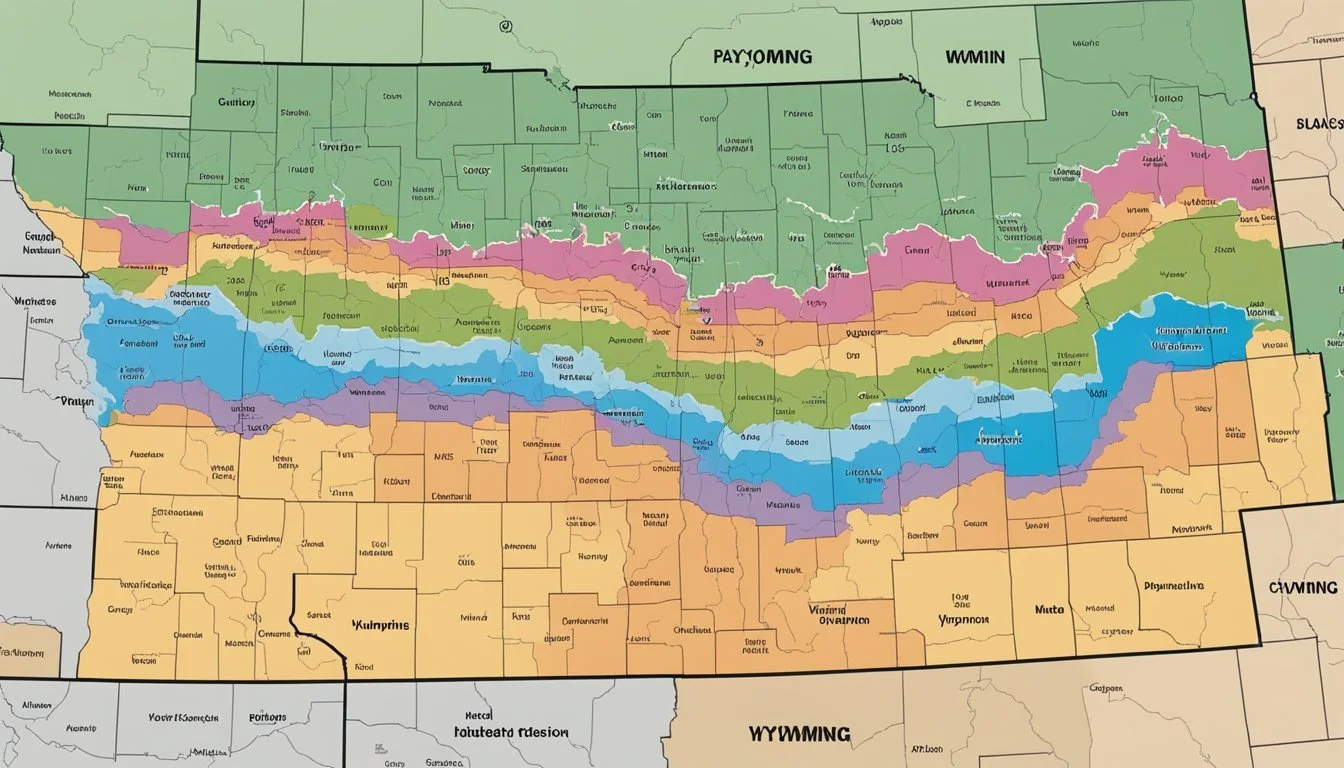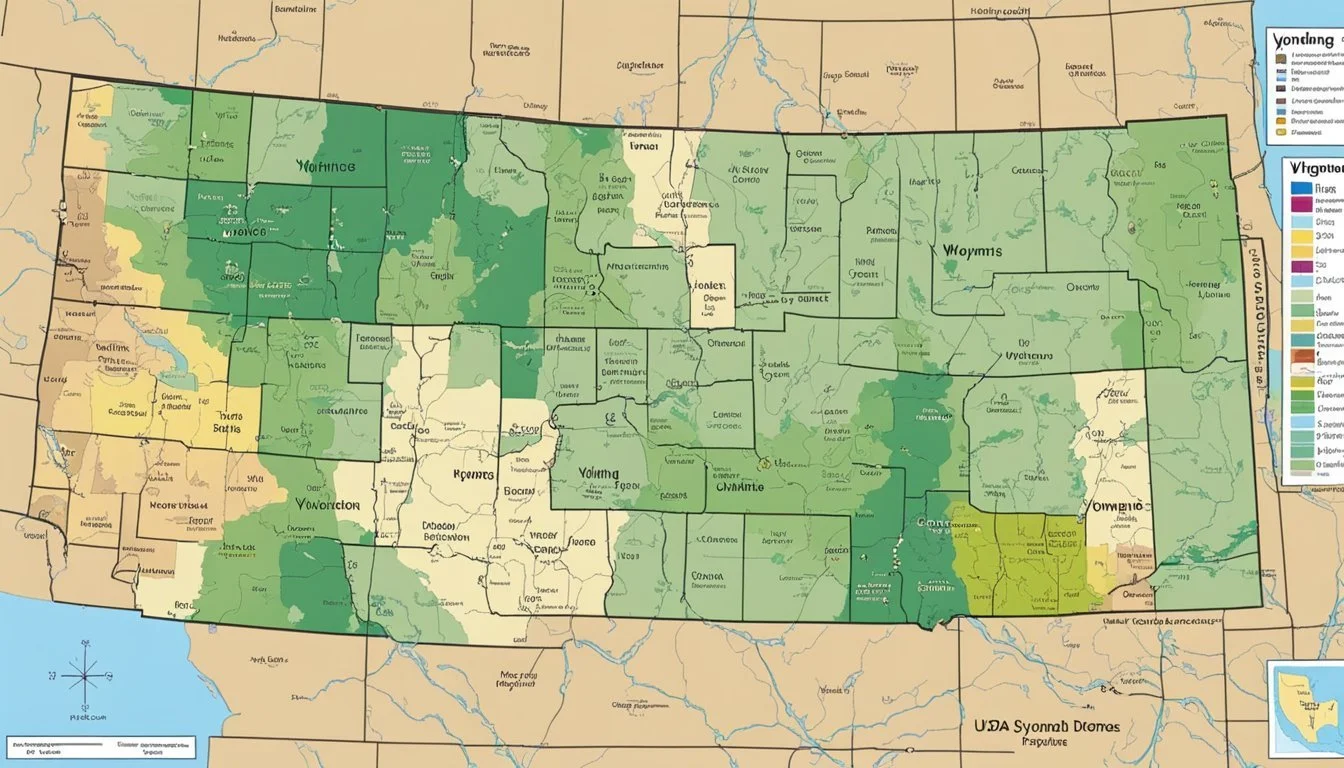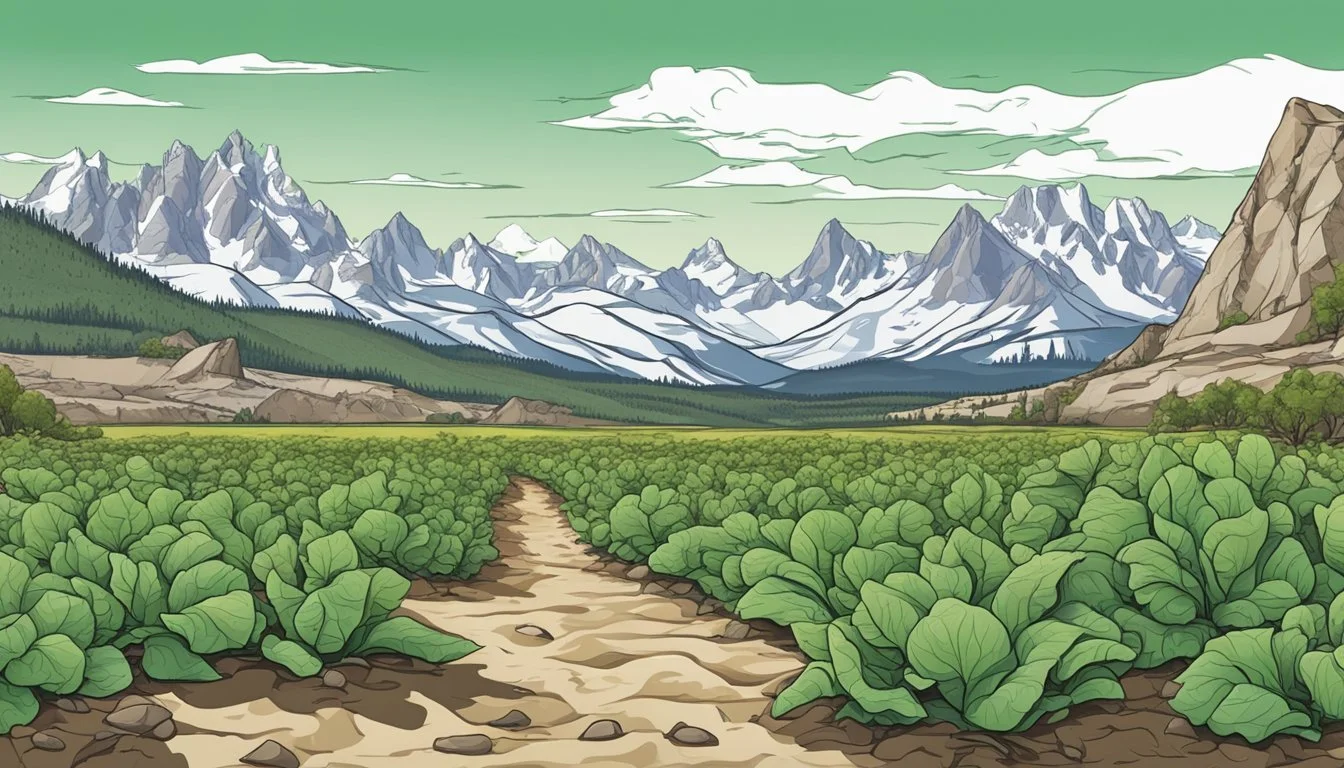USDA Hardiness Zones in Wyoming
Navigating the Climate for Gardeners
Understanding the USDA Hardiness Zones is crucial for gardeners and agricultural producers in Wyoming. These zones are a standard guide that delineates where various perennial plants are most likely to thrive based on climatic conditions. In Wyoming, these zones can range from the frigid 2a zone, indicating average extreme minimum temperatures of -50°F to -45°F, to the milder 4a zone, with lows of -30°F to -25°F. By consulting the 2023 USDA Plant Hardiness Zone Map, individuals can make informed decisions about what plants are suitable for their locales.
The USDA Plant Hardiness Zone Map has undergone updates to reflect more accurate data, making it an indispensable tool for anyone with a stake in horticulture or agriculture. These zones are determined by the average annual extreme minimum winter temperature over a 30-year period. The latest revisions, which consider climate data from 1991 to 2020, show significant changes from previous maps. Users can refer to resources like the Plantmaps to interactively explore the specific hardiness zones across different parts of Wyoming.
By aligning planting strategies with the map's zones, cultivators can substantially increase their chances of success. The zones serve as a foundational element in plant selection and gardening planning, affecting choices from the micro-scale of home gardens to the macro-scale of commercial agriculture. Given Wyoming's varied topography, from mountain ranges to plains, the USDA hardiness zones vary significantly across the state, a fact that emphasizes the importance of local knowledge in agricultural and horticultural practices.
Understanding USDA Hardiness Zones
USDA Hardiness Zones are designated by the United States Department of Agriculture's Plant Hardiness Zone Map. These zones classify regions based on their average annual extreme minimum winter temperature. This categorization helps gardeners and landscapers determine the most suitable perennials for their area.
The map divides the country into zones of 10-degree Fahrenheit increments, with these increments further split into 5-degree half zones indicated by "a" (warmer) and "b" (colder) suffixes. Understanding these zones is crucial for successful gardening and cultivation, as plants have specific cold tolerances that are often stated in terms of their hardiness zone ratings.
For example:
Zone 2a: -50°F to -45°F
Zone 2b: -45°F to -40°F
Zone 3a: -40°F to -35°F
Zone 3b: -35°F to -30°F
Zone 4a: -30°F to -25°F
Wyoming, characterized by its varied topography and climate, features several of these zones due to its wide-ranging temperatures. Gardeners can reference the Wyoming Interactive USDA Plant Hardiness Zone Map to pinpoint their exact locale and thus, make more informed decisions about what to plant.
When consulting the USDA Plant Hardiness Zone Map, stakeholders find a valuable tool to mitigate the risk of plant loss due to winter cold, enhancing both commercial and hobbyist horticulture outcomes. It distills decades of weather station data to guide users toward the most climate-appropriate perennials.
The Specifics of Wyoming’s Climate
Wyoming's climate exhibits characteristics of a semi-arid, continental region. The state experiences a wide range of temperatures, indicative of its expansive plains and rugged mountain ranges.
Winter brings considerably low temperatures, known for reaching extreme minimum winter temperatures that can greatly affect plant hardiness. As per the updated USDA Plant Hardiness Zone Map, the zones articulate these extreme minimum temperatures, vital for understanding regional climate change impacts.
Average Winter Temperatures in Wyoming:
Zone 2a
Zone 2b
Zone 3a
Zone 3b
Zone 4a
Climatically, the state sees a winter temperature fluctuation that's particularly distinct in the high-altitude areas, where temperatures are generally cooler. Taking into account climate change, shifts in environment conditions have been observed, potentially altering the plant survival metrics.
Inhabitants and horticulturists alike heed these climate details for successful cultivation and environmental management. The environment's susceptibility to climate change suggests a need for ongoing observations to ensure accurate, comprehensive descriptions of Wyoming’s climate.
Navigating the USDA Plant Hardiness Zone Map
The USDA Plant Hardiness Zone Map is a valuable tool for gardeners and researchers alike, providing insight into which perennial plants will thrive in various locations. This map charts the average annual extreme minimum winter temperatures, delineating areas by 10-degree F zones and further splitting them into 5-degree F half zones for greater precision.
To use the map, a user can start by employing the search box located on the website. By simply entering a zip code, the map swiftly zooms in to provide detailed information on the specific zone correlated with the entered location. The map utilizes GIS (Geographic Information Systems) technology to allow for a seamless online experience, ensuring that the user can navigate the national map with ease to find state-level details.
It's important to note that along with the contiguous United States, the map also covers territories such as Alaska, Puerto Rico, and Hawaii. The map's scope guarantees inclusivity, extending its utility to a national scale. Gardeners in distinct geographic areas like Maine, Oregon, and Washington will find the map equally handy, thanks to the map's extensive reach and periodic updates maintaining its relevancy.
The USDA Plant Hardiness Zone Map is also dynamic, providing more than just static information. Users can explore different layers of detail, viewing state maps with an overlay of county lines for added context and precision.
For further refinement, the map offers a GIS-based interactive format. This feature is particularly helpful for users requiring a more analytical approach, such as landscape architects or urban planners, who may need to evaluate compatibility of plant species with local climates across different regions.
Hardiness Zones in Wyoming Cities and Towns
Wyoming's diverse topography leads to a variety of USDA Hardiness Zones across its cities and towns. This classification assists gardeners and agriculturists in determining plant viability and selection based on local climates.
Northern Wyoming Hardiness
Northern Wyoming towns such as Sheridan fall into the Hardiness Zones 4a to 5a, which means the regions experience winter lows reaching -30°F to -15°F. Sheridan's relatively colder climate guides local gardeners in choosing plants that can withstand harsh winters.
Southern Wyoming Hardiness
In contrast, Southern Wyoming cities like Cheyenne and Laramie often see zones ranging from 5a to 5b. This zone indicates minimum temperatures of -20°F to -10°F. These cities' slightly milder winters allow for a different range of suitable plants compared to the northern parts of the state.
Eastern Wyoming Hardiness
Gillette, located in Eastern Wyoming, generally aligns with zone 4b, enduring temperatures as low as -25°F to -20°F. Cities in this region reflect a gradient of cold tolerance, necessary for robust agricultural planning.
Western Wyoming Hardiness
Western Wyoming features towns like Jackson and Evanston, which are categorized from zone 3a to 5b, encountering winter extremities of -40°F to -10°F. This wide range reflects the high altitude and varied terrain of the area, impacting gardening strategies significantly.
Selecting Appropriate Plants for Wyoming
When choosing perennial plants for Wyoming gardens, gardeners and growers should consult the Interactive USDA Plant Hardiness Zone Map. Wyoming's zones range from 2a to 4a, indicating potential winter lows between -50°F to -30°F. This information is crucial for the survival of plants through harsh winters.
Trees and shrubs selected for landscaping should be hardy to these conditions. For example:
Zone 2a: Picea glauca (White Spruce)
Zone 3b: Acer nigrum (Black Maple)
Starting with trees and shrubs that naturally withstand cold temperatures can ensure a healthy, thriving yard.
For a vibrant garden, selecting flowers adaptable to Wyoming's climate is also essential. Some robust options include:
Echinacea purpurea (Purple Coneflower)
Rudbeckia hirta (Black-eyed Susan)
These species are renowned for their durability and can bring color and life to gardens even in cooler climates.
Gardeners may visit a local nursery to get advice on varieties that perform best in their specific zone. Nurseries often provide plants that are pre-acclimated to the local environment, increasing the chances of successful cultivation.
Creating a thriving garden in Wyoming requires careful planning and selection of plants that match the local hardiness zone. By focusing on species suited to the local climate, gardeners can enjoy a flourishing outdoor space year after year.
Impacts of Climate Change on Gardening
Climate change is reshaping the gardening landscape in Wyoming. As the environment warms, gardeners are noticing changes in the traditional growing seasons. Growing degree days (GDD)—a measure of heat accumulation used to predict plant development rates—are increasing, allowing for a longer growing season in some areas.
Plant hardiness zones, which classify regions based on the coldest temperatures they experience, have shifted. These zones are crucial for determining what plants can survive the winter in a particular location. Wyoming gardeners see zones creeping northward, indicating warming trends.
Heat Zones: Another factor influenced by climate change is the number of days above certain temperature thresholds, known as heat zones. These are becoming more prevalent, affecting plant stress and survival.
In Wyoming, changes in precipitation patterns and more extreme weather events also affect gardening. Drought-resistant and heat-tolerant plant varieties are becoming more necessary, as gardeners adapt to less predictable water availability.
Adaptation is key, and Wyoming gardeners are turning to new practices and plant selections to keep their gardens thriving. Some are incorporating:
Drip irrigation systems for water efficiency
Mulching to retain soil moisture
Planting native species that are more tolerant to changing environmental conditions
By adjusting gardening practices, Wyoming’s green thumbs are finding ways to work with the evolving environment while continuing to cultivate their passion for growing.
Caring for Your Garden Throughout the Seasons
In Wyoming, gardeners face unique challenges due to the state's harsh winters and fluctuating winter temperatures. It's crucial for them to plan meticulously to protect their gardens and take full advantage of the shorter growing season.
Preparing for a Wyoming Winter
As fall approaches, Wyoming gardeners must prepare their yards for the onset of winter, characterized by heavy snow and extreme cold. Mulching is essential; a thick layer can safeguard the roots of perennials from freezing temperatures. Wrapping young trees and shrubs in burlap can also prevent winter burn caused by icy winds and intense sun. Additionally, they should consider drainage to prevent water from pooling and freezing around plants, which could lead to root damage.
Maximizing the Growing Season
To make the most of the Wyoming growing season, gardeners should start seeds indoors well before the last expected frost date, usually using a USDA Hardiness Zone Map as a reference. When the climate moderates, they can transition those seedlings outdoors. Selecting plant varieties that thrive within Wyoming's Hardiness Zones typically 3-5, and are capable of maturing quickly is also vital. Use of cold frames or hoop houses can extend the growing season by protecting plants from unexpected spring or fall frosts. Gardeners should monitor temperatures closely and be ready to cover delicate plants if a sudden drop threatens.
Utilizing Government Resources for Gardeners
Gardeners in Wyoming looking to optimize their plant selection can greatly benefit from resources provided by the government, particularly the USDA Plant Hardiness Zone Map. This tool is integral for determining the most suitable plants for a specific location.
The map segments the nation into zones reflecting the average annual extreme minimum winter temperature. For Wyoming, the zones range from 2a to 4b, indicating notable variance in climate conditions across the state. Gardeners should refer to the detailed zones to guide their plant choices.
Key Government Resources:
USDA Plant Hardiness Zone Map: The authoritative guide for regional planting.
State Agricultural Extension Offices: They provide localized advice and information for gardeners and farmers.
Online Tools and Databases: Websites like Plantmaps offer interactive maps specific to Wyoming, made with up-to-date government data.
Steps for Gardeners:
Identify your specific hardiness zone using the USDA map.
Consult your state's agricultural extension office for tailored planting advice.
Use online databases to explore plants suitable for your zone.
By utilizing these government databases, gardeners can make informed decisions, ensuring their horticultural efforts are both enjoyable and fruitful. They provide a solid foundation of knowledge, perfectly meshing with the gardener's local understanding and expertise.
Frequently Asked Questions
Understanding the USDA Hardiness Zones is crucial for gardeners and agriculturists in Wyoming, as it assists in selecting the right plants that can thrive in the state's variable climatic conditions.
How can I find the USDA Hardiness Zone for a specific location in Wyoming?
One can easily access the official 2023 USDA Plant Hardiness Zone Map for the most accurate and updated information regarding the hardiness zones of any location in Wyoming.
What are the temperature ranges for the different hardiness zones within Wyoming?
Wyoming encompasses a range of hardiness zones with temperature extremes from Zone 2a, with average annual minimum temperatures between -50°F to -45°F, to Zone 5b with temperatures -15°F to -10°F. Please refer to Plantmaps for detailed temperature ranges.
Where can I find a climate zone map for the state of Wyoming?
The USDA Hardiness Zone Map provides a detailed climate zone map specific to Wyoming, showing various regions and their corresponding zones.
What are the specific hardiness zones for major cities in Wyoming, such as Cheyenne and Casper?
Cheyenne falls in Zone 5b, while Casper is in Zone 4b. These zones indicate the plants suitable for cultivation based on the cities’ winter temperature lows.
How does Wyoming's climate affect gardening and planting in the various hardiness zones?
The climate affects planting in Wyoming by determining the survivability of certain plants during the coldest months. Gardeners must choose plant species that align with their location's typical temperature lows as indicated by its USDA zone designation.
Are there online resources that provide detailed hardiness zone maps for Wyoming?
In addition to the USDA's official map, websites like Gardening Know How offer detailed hardiness zone maps and gardening advice specific to Wyoming.







